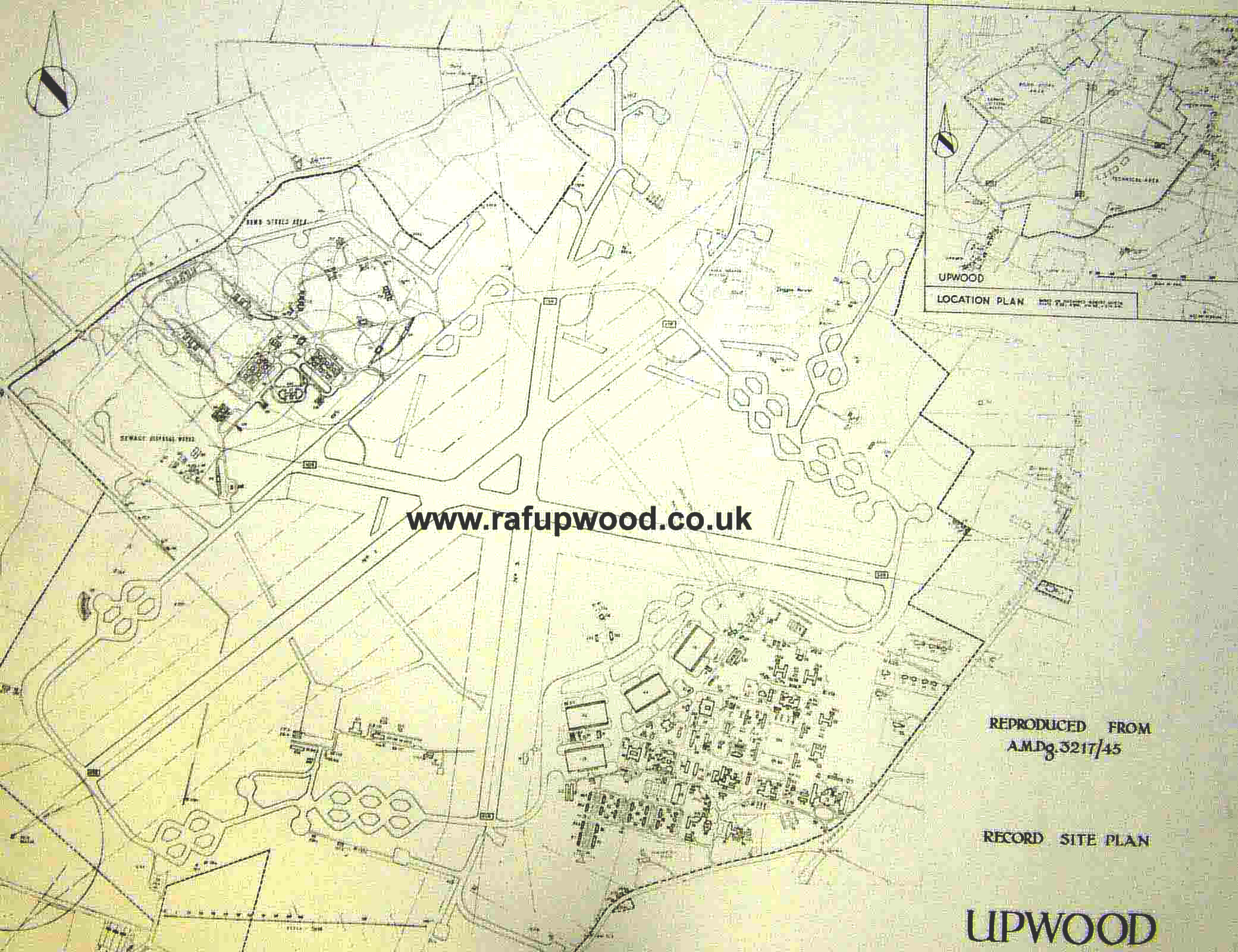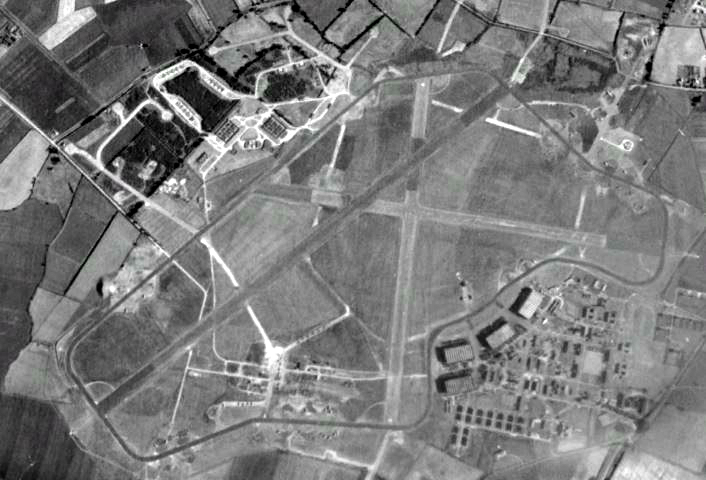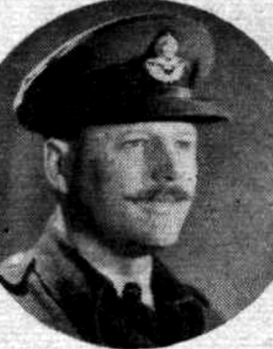RAF Upwood was situated 1¾-miles South-west of Ramsey, Hunts, (Cambs).
Construction / Layout – It was a WWI Landing Ground which was reconstructed as part of the RAF Expansion Scheme (Scheme C) during 1935-1936 &“ it Opened in 1937. The 4–C-Type Hangars along with the Technical & Domestic Site were Grouped together alongside the Flying Field. In April 1940 Work started on the Construction of Hard Standings & a Perimeter Track. Between May & October 1943 the 3-Runways (1 x 2000-yds, 1 x 1600-yds, 1 x 1400-yds) were added & the Perimeter Track & Hard Standings were re-Built.

The old WW1 Airfield Site was selected to be reactivated & expanded. The New Station was Designed to Accommodate 2-Medium Bomber Squadrons with Room for a 3rd. By 1936, Construction had begun in Earnest with 2 of 5 C-Type Hangars started. On 27th February 1937 the 1st Flying Unit arrived at RAF Upwood in the form of No.52 Squadron RAF Flying Hawker Hinds.

This Unit was Joined on 1st March 1937 by No.63 Squadron & its Hawker Audaxes.

During their time at Upwood, No.52 & 63 Squadrons became Training Units & took on both Fairey Battle & Avro Anson Aircraft. In August & September 1939, the 2-Squadrons were reassigned Opening the Field up to its New Tenant, No.90 Squadron Flying Bristol Blenheims. 17-OTU Raf Upwood formed on the 4th April 1940, from the Resident 35 & 90-Squadrons, which were both equipped with Blenheims & Ansons. To allow for Expansion, 17-OTU was divided into 4-Flights on 14th May 1940: ‘A‘ (Conversion) Flight; ‘B‘ (Anson) Flight; ‘C‘ (Armament) Flight & ‘D‘ (Operational Training) Flight. 17-OTU left from Upwood on 24th April 1943 for RAF Silverstone.

On 13th July 1940, Sgt Tom G Jefferson was Posted to No.17 OTU, RAF Upwood, Cambs on Blenheims! 17-OTU was formed in April 1940 as part of No.6-Group RAF Bomber Command at RAF Upwood to Train Light Bomber Crews using the Bristol Blenheim.

Tom recalls: ‘I thought it was because 2-Group had big Losses & they wanted Pilots there. So I was Switched & so were other people, on to Blenheim’s! A friend of mine, whose name was ‘Rob Royle‘ [not sure of the spelling] – he went through & went onto a Hampden Squadron. Now, looking at my Notes, I can’t understand why we were there so long! Because I thought we’d been sent onto Blenheims, because of the [High] Chop-rate – they wanted Replacement Pilots quickly.’
I told Tom that I thought I knew why: ‘I’ve heard about this & it was apparently due to Wg Cdr Tom Webster [Sqn Ldr at that time] who was the CO [25th October 1940 – 1st May 1941] – he didn’t really push Crews through very quickly – they took an enormous time to get through. I think that he reasoned that they needed Longer on the OTU to Assimilate everything – if you throw them out too quickly, they are just going to Die through Lack of Experience.’ This is what happened, of course, when we were desperately short of Pilots during the Battle of Britain & they were sent to Squadrons with no more than 12-hours on Type, with predictable Results. This made me recheck how long my Cousin was on the Course at No,17-OTU. Just 4-months – 5th March to 3rd July 1941! It would seem that Tom Webster‘s Replacement held a different View.
Tom continues: ‘I 1st went Solo on a Bull-nosed Mk I Blenheim. A Chap called Cree – I think he was a Flying Officer – took me round to Familiarise me with it, & sent me Solo & all the rest of it, which was Straight Forward.’
I have already mentioned in my Biography of Wing Commander Tom Webster the occasion he took Tom Jefferson Flying through a Weather Front & explained the effect of Flying through different Atmospheric Pressures. In my time, we learned the Pneumonic High-Low-High, i.e., if Flying from High Pressure toward Low Pressure, your Altimeter would read High.
Tom concluded as I wrote earlier, with this glowing accolade for Wing Co Webster: ‘He was a helluva nice Chap, being unusually helpful to some miserable little Sprog Sergeant.’ One good reason for the Lack of Progress on No.17-OTU at this time was the appalling Weather during the Winter of 1940/41.
Tom recalls: ‘In this very bad Winter, the Grass Aerodrome was Waterlogged – covered with Snow & Slush – & we were absolutely Grounded. So somebody, probably a Crew, thought up the idea of using nearby RAF Alconbury (1938).’ This Airfield had been used as a Satellite since the Outbreak of WW2, but it was then in the process of a Major Upgrade to a Fully Operational one, with a Concrete Runway & Associated Infrastructure. The only snag was that it wasn’t actually Open! Tom was instructed to ‘nip over there‘ & Assess the Situation. He found the Runway usable but most of the Buildings were only half-finished. Good enough, they thought!
Tom continues: ‘So we took some Blenheim’s over & had some Guards over there to look after them. The Crews used to go over every morning, in Lorries, with an Ambulance & all the rest of the Flying Back-up. We’d do some Flying from there & then go back in the Evening. I used to go back with the Doctor, in the Ambulance! He had great big Stone Jars of really 100%-proof Naval Rum, because the Guards who were on Duty there, in these diabolical conditions all Night, had to have Rum! Of course, they couldn’t Drink all these big Bottles!’
I naturally asked Tom if he had to help! He agreed, laughing!
Tom has good reason for remembering his Flights on 14th & 15th March 1941: ‘We had an Aircraft go down in the Irish Sea, between Blackpool & Jurby (on the Isle of Man) & somebody had to go up & Identify the Bodies. I went up to Fleetwood. Two Bodies had been picked up by a Fishing Boat, but they were not the Actual Crew. Not very nice – they had been in the Water for some time. Well, coming back from Fleetwood, to RAF Upwood again, as I was nearing Chester, I experienced a shudder & judder on, I think, the Starboard Engine. I tried the Magneto Switches & I got a Mag Drop. So I thought, right, I’ll just curl her Round into Sealand – dead easy, which I did. I arranged for the Aircraft to be Serviced & the Mag Drop checked. Then, because my Fiancée Elsie (Joey) was in Chester, I nipped down & saw her. On the spur of the moment, we went for a walk in the Park at Chester & I said, let’s get Married! Because I thought, well, at least you’ll get a little Pension, or something if I am Killed. I thought, you know, I’m sure to Go-in before long & it was the beginning of the War & to Live the whole of the War wasn’t a strong possibility. It seemed it was going to go on for a Geat Long Time & the Chop-rate was High & I’d had some Lucky Escapes, one way or another. This was the sort of thinking in those days. We went to the Vicar of All Saints Church, in Hoole [2-Vicarage Road, Chester], the Parish in which my Fiancée lived. Very fortunately, he was in, because he had broken his leg! He accepted that my Fiancée Elsie (Joey) had lived in the Parish long enough, but said, well, you haven’t! I said, well, I have because I was at Sealand. He replied, ah, well, I think that I can allow that! He married us. Ralph Millns, Tom’s Observer was a Witness. We spent the Night in Chester, went home & told my Wife’s mother. Oh Dear – she nearly passed out! Fortunately, I’d had the presence of mind to take her half a Bottle of Whisky, or something, to get the Old Girl to come to Terms with the News. We went off and spent the Night in Chester. The next morning, I put my Wife on the Train at Chester Station, bound for Peterborough. I then went back to Sealand, picked up my Aircraft, checked it out & Took-off. I found my Elsie’s Train & gave it a real thorough Beating up, Flying alongside the Carriage & Waving to each other. After Landing at Upwood, I explained my new Marital Status to the CO. He said: “You’re supposed to get the CO‘s Permission before you get Married!” & I said: “Well, I didn’t know, Sir. I’m very Sorry about that.” He said: “Well, you know, we’re not going to make any Fuss about it, but you ought to have remembered it!” I don’t think it was Tom Webster – it must have been a Flight Commander. Anyway, he added: “It was a very good Trip – you getting up there & helping us identify the Dead Corporal.” So I got in my Car – drove into Peterborough – met the Train coming in – took my new Wife down to Ramsey, on the edge of Upwood & Found some Lodgings for her – all that same Night! Very hectic this was!’
On 28th June 1941, Sgt Tom G Jefferson joined No.18 Squadron, RAF Oulton, Cambs aged 27-Yrs
